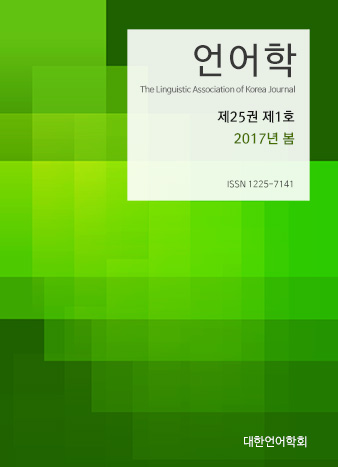대한언어학회 전자저널

-
Why is the Locative NP in Kiswahili not Syntactically Oblique?
-
Developmental Errors in Chinese L1 Speakers’ Use of the L2 English Past Tense and Perfective Aspect
-
An Exploration of High School Reading Test Items Based on Discriminant Analysis
-
Marketization of University Brochures in Korea and the US: From a Genre Analysis Perspective
25권 1호 (2017년 3월)
- 구성원소 이론을 통한 한국어 구개음화 현상 연구
-
정진희
Pages : 163-181
Abstract
Keywords
# 구성원소 이론(Element Theory) # 구개음화(palatalization) # 일원적 체계(monovalent system) # 내적 구조(internal represantation)
References
- 김정우. (1997). 조음 자질과 음향 자질. 국어학, 29, 51-70.
- 김정우. (2001). 음운 변화와 변별 자질 체계 —구개음화와 관련된 자음 체계의 변화를 중심으로. 배달말, 29, 31-52.
- 김주필. (2015). 구개음화의 통시성과 역동성. 국어학총서, 26, 국어학회
- 노채환. (2015). 한국어 음절핵의 해석과 음운현상. 한국외국어대학교 박사학위 논문.
- 송철의. (2008). 국어의 음운현상과 변별적 자질. 송철의(편). 한국어 형태음운론적 연구(pp. 37-54) 파주: 태학사.
- 소신애. (2014). 비어두 위치의 ㄱ구개음화에 대하여. 국어국문학, 167, 5-39.
- 심보. (2016). 한국어 자음의 내적 구조와 음운현상 연구 : 구성원소 이론(Element Theory)을 바탕으로. 한국외국어대학교 박사학위 논문.
- 신승용. (1996). 치음의 통시적 변화와 음운론적 해석. 서강대학교 석사학위 논문.
- 신승용. (2003). 음운변화의 원인과 과정. 국어학총서, 43, 국어학회. 파주: 태학사.
- 이기문. (1972). 개정 국어사개설. 서울: 탑출판사.
- 이기문. (1998). 신정판 국어사개설. 파주: 태학사.
- 이동석. (2010). ㅎ구개음화 현상에 대한 연구. 언어학 연구, 17, 195-214.
- 이진호. (2014). 국어음운론강의. 서울: 삼경문화사.
- 이상직. (2006). 구성원소 이론과 국어의 자음표시. 언어학, 46, 3-29.
- 이승환. (1973). 구개음화 현상에 대한 생성 음운 규칙. 한글, 152, 367-380.
- 정진희. (2016). 구성원소 이론과 한국어 치조음의 음운 표시. 우리말글, 71, 61-83.
- 허용, 이상직. (1996). 지배음운론(Government Phonology)이란 무엇인가?. 언어학, 19, 411-442.
- 허웅. (1964) 齒音攷. 국어국문학, 27, 44-54.
- Backley, P. (2011). An introduction to element theory. Edinburgh: Edinburgh University Press.
- Broadbent, J. (1991). Linking and intrusive r in English. UCL Working Papers in Linguistics, 3, 281-302.
- Harris, J. (1990). Segmental complexity and phonological government. Phonology, 7(1), 255-300.
- Harris, J. (1994). English sound structure. Oxford: Blackwell.
- Harris, J., & Lindsey, G. (1995). The elements of phonological representation. In J. Durand & F. Katamba (Eds.), Frontiers of phonology: atoms, structures, derivations, (pp. 34-79). London; New York: Routledge.
- Heo, Y. (1994). Empty categories and Korean phonology. Unpublished doctoral dissertation. SOAS University of London. London.
- Kaye, J., Lowenstamm, J., & Vergnaud, J. R. (1985). The internal structure of phonological elements: A theory of charm and government. Phonology, 2(1), 305-328.
- Kim, S. J. (1996). The representations of Korean phonological expressions and their consequences. Unpublished doctoral dissertation. SOAS University of London. London.
- Lass, R. (1984). Phonology: An introduction to basic concepts. Cambridge University Press.
- Maddieson, I., & Emmorey, K. (1985). Relationship between semivowels and vowels: cross-linguistic investigations of acoustic difference and coarticulation. Phonetica, 42(4), 163-174.
- Nevins, A., & Chitoran, I. (2008). Phonological representations and the variable patterning of glides. Lingua, 118(12), 1979-1997.
- Padgett, J. (2008). Glides, vowels, and features. Lingua, 118(12), 1937-1955.
- Yoshida, S. (2001). An element-based analysis of affrication in Japanese. In J. Weijer & T. Nishihara (Eds.), Issues in Japanese Phonology and Morphology, 51, (pp. 193-214). Berlin: New York: Mouton de Gruyter.
- Yoshida, S. (1996). Phonological government in Japanese. Australian: Australian National University.